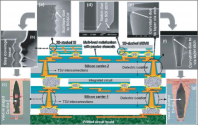backend tools have requirements for large exposure field, so the relative overlay error still needs to be small and the optical systems will need to be different than frontend tools.Advanced packaging tool performance will be improved but still not state of the art.
For example, backend steppers resolution has been in the 1um / 2um range whereas frontend scanner resolution is now at 13.5nm and moving even lower. Even the frontend iline scanners/steppers has resolution limit of 0.28um (280nm).
Going into heterogeneous integration, backend lithography tool will have to move into the gap that previously separated frontend and backend litho. The 2.5D/3D steppers from SMEE will be redefined to provide improved resolution down to 0.5um.
So, yes, backend tools are expected to have improved performance, but again, it's still not state-of-the-art compared to frontend tools. We'll be mostly implementing or porting known features or methods learned from frontend to backend.
Like I said earlier, since advanced packaging will be dealing in a larger physical size range (on a "um" scale), we could afford much much larger error tolerance, so hence not difficult at all (relative to the technology we have to come up with on a "nm" scale in the FE).
P.S. state-of-the-art = higher price tag. you can clearly see the difference in the level of technology by looking at the big price delta between FE & BE equipments. And new BE tool may be state-of-the-art versus older BE tool, but compared to older FE tools, it's still not very "state-of-the-art". It's all relative. right?
chip packaging has different requirements. porting front end tools won't work that well and specialized tools will need to be developed. another example is TSV. etch for TSV is very different than standard etches due to the very high aspect ratio required.


